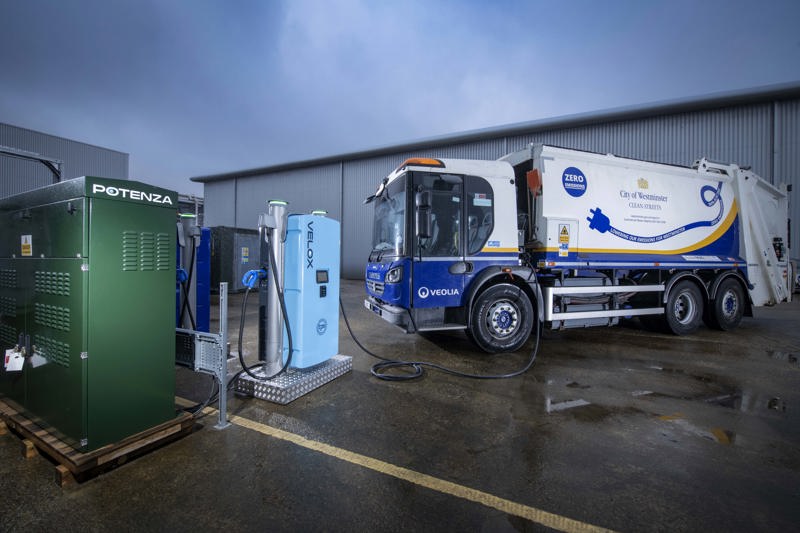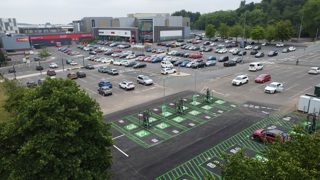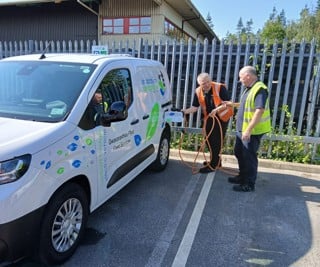This feature was taken from our special Electric Vehicle Charging Insight report.

The concept of vehicle-to-grid (V2G) - using the batteries in electric vehicles (EVs) to feed energy back to the electricity network at times of peak demand – is not a new one.
But growing demands on the UK’s electricity system, ever-rising numbers of EVs on UK roads and an increasing number of trials means it is coming closer to reality.
For fleets, this means their vehicles could be used as hundreds of small-scale power stations, selling electricity back to the grid at peak times when it is at its most expensive, and charging when demand – and the cost of energy – drops.
This will contribute to grid stability by regulating frequency and voltage, and even store excess renewable energy for later use.
“Historically, fleet vehicles have generated revenue only when operational,” says Adam Hall, director at Drax Electric Vehicles.
“What V2G offers, in principle, is the opportunity for fleets to generate revenue in their downtime too.”
V2G is one step on from smart charging, which is when a vehicle is charged to a pre-determined level over a certain time slot.
With this period, the smart charger ‘talks’ to the grid to ensure electricity is taken at times when supply is high and demand is low, therefore reducing peaks and balancing the grid.
However, while this will help manage electricity taken from the grid, it is not as sophisticated as V2G, which allows energy to flow both ways.
How much a fleet could earn this way is, as yet, unknown. However, in 2022 the National Grid and energy provider Octopus Energy collaborated on the Powerloop trial which tested V2G with domestic customers.
They recruited 135 households with a combined maximum capacity of less than 1mW and focused on two overnight sessions, running from 5pm to 5am.
When the findings were adjusted to an annual mileage of 10,000 miles, Octopus Energy reported the customers could realise a saving of up to £840 a year compared with unmanaged charging on a flat tariff, and £180 over solely using a smart charger.
Meeting energy demands
The incentives to reduce peaks of demand on the grid are because V2G will help National Grid meet future energy demands while minimising the amount of money needed to be spent upgrading the country’s electricity system.
Russell Fowler, senior manager, decarbonisation, at the National Grid, told the Lords Select Committee on Environment and Climate Change that V2G – together with smart charging – could amount to a £1.4 billion reduction in investment required.
The current capacity of the grid is 76gW and National Grid, in one of its Future Energy Scenarios for 2050, estimates the overall range of capacity needed for all uses will be between 285gW and 385gW by 2050.
It says wind and solar capacity will generate between 149gW and 239gW, with nuclear and fossil fuels (with carbon capture) making up the remainder.
“In one of National Grid’s Future Energy Scenarios, V2G could provide up to 38gW of flexible power from 5.5 million EVs,” says Hall.
“That extra electricity would cover all the extra peak power the UK needs in the highest-demand scenario for 2050.”
The Government has recognised the potential importance of V2G in the UK’s future energy infrastructure and has provided funds towards trials through initiatives such as the £12.6 million V2X Innovation Programme, launched in March 2022.
One of the most recent funding awards (£1.3m) from this has gone to a consortium led by solar car park installer, funder and operator 3ti for a project setting out to integrate bi-directional DC charging into a pop-up solar car park and EV charging hub. This will provide bi-directional EV charging at speeds up to 30kW.
“Everybody wants more EVs on the grid,” says Mark Potter, chief technical officer at 3ti. “They represent a massive scale, distributed energy resource that can be used to balance real-time supply and demand.
“Being able to recharge at 30kW is critical to success in this market. In destination charging, most EVs will only charge at 7kW or 11kW using AC, even if the charge point is rated at 22kW.
“Being able to charge at 30kW regardless of vehicle limitations makes more energy available for V2G export without impacting the overall net charge. This project will prove that bi-directional EV charging can work in the real world.”
Fleet trials of V2G
Fleets are also carrying out their own trials, with organisations such as Islington Council, Nottingham City Council and Veolia having done this.
For example, waste collection fleet operator Veolia, which plans to electrify all its 1,800 refuse collection vehicles (RCVs) by 2040, has trialled two specially-designed bi-directional vehicles.
This saw 110kW of energy charged and discharged from them, enough to supply power to 110 households for more than two hours during peak evening hours.
It estimates the electrification of its fleet will enable the company to provide around 200mW of flexible power capacity to the grid daily, the equivalent of the evening peak energy demand of more than 150,000 homes.
Veolia says RCVs are ideally suited to V2G as their batteries are six times larger than those in an average car, and the fleet is usually parked at peak energy consumption times.
It now plans to expand the trial and test it out on the streets, using Westminster Council collection vehicles to pilot the innovation.
While trials and modelling exercises are proving the potential of V2G, there are still obstacles to overcome before it enters the mainstream.
These include the high cost of the bi-directional chargers compared with smart chargers, the need for participating vehicles to be connected to the grid at the right times, as well as the limited number of vehicles which have V2G capability fitted.
In the UK, the Nissan Leaf has been the only passenger car with the capability, but some manufacturers have committed to releasing V2G-ready models soon.
For example, Volvo’s EX90 SUV will be the first Volvo equipped with the necessary hardware to enable bi-directional charging, while Renault has recently announced its commercial V2G offering, starting this year in France and Germany, and coming to the UK next year.
Last year it announced the electric Renault 5 will be the maker’s first car to come with a bi-directional on-board charger.
“V2G technology will soon become more affordable, and organisations with EV fleets will be in a key position to benefit,” says Hall.
Charging is one of the biggest challenges faced by fleets and their drivers in the transition to full electric. In our latest Fleet News special report, we break down the challenges affecting each of the charging types - home, workplace and public - and provide advice and guidance to help you navigate your way through the EV transition journey.





















Login to comment
Comments
No comments have been made yet.